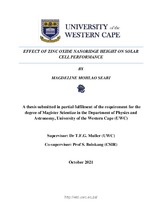| dc.contributor.advisor | Muller, T.F.G. | |
| dc.contributor.advisor | Bolokang, S. | |
| dc.contributor.author | Seabi, Magdeline Mohlao | |
| dc.date.accessioned | 2022-01-18T11:51:57Z | |
| dc.date.available | 2022-01-18T11:51:57Z | |
| dc.date.issued | 2021 | |
| dc.identifier.uri | http://hdl.handle.net/11394/8602 | |
| dc.description | >Magister Scientiae - MSc | en_US |
| dc.description.abstract | Environmentally friendly photovoltaic devices make use of solar radiation as the energy source to generate electricity. Organic solar cells (OSCs) have been making headway in the last decade due to their cost-effectiveness and potential application in flexible devices. One of the disadvantages of OSCs is the short lifetime of the charge carriers, where the various interfaces that are present in the material play a significant role. In the inverted organic solar cell (IOSC), electrons are injected into the transparent conducting oxide, whereby the electrode alignment is reversed compared to the conventional structure. Nanosized zinc oxide (ZnO) thin-films with nanoridges/ripples embedded on the surface of the thin-film can be used as an electron transport/hole-blocking layers in inverted organic solar cells to enhance light-capturing by the active layer of the solar cell. | en_US |
| dc.language.iso | en | en_US |
| dc.publisher | University of Western Cape | en_US |
| dc.subject | Electron transporting layer | en_US |
| dc.subject | Nanoparticles | en_US |
| dc.subject | Metal oxide | en_US |
| dc.subject | Inverted organic solar cell | en_US |
| dc.subject | Spin coating | en_US |
| dc.title | Effect of zinc oxide nanoridge height on solar cell performance | en_US |
| dc.rights.holder | University of Western Cape | en_US |

